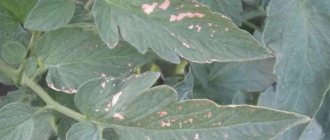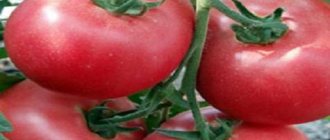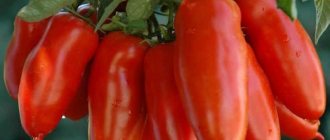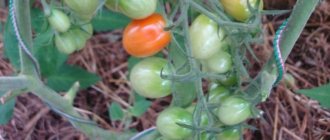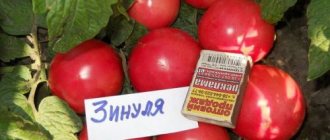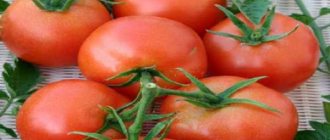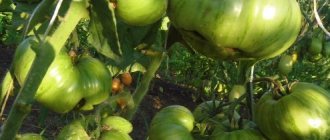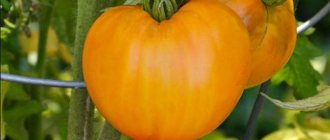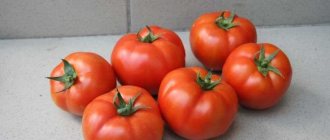Description of the variety
The Thumbelina variety is determinate and tall. The bushes reach a height of 1.5 meters, and sometimes 2. Therefore, it is worth pinching the top at a plant height of 1.5 m - this will have a beneficial effect on the development of the fruit.
Reference. In determinate varieties of tomatoes, it is necessary to remove growing points.
According to the speed of ripening, Thumbelina is classified as an early ripening plant. The first harvest is obtained 90 days after planting the seeds.
This variety is grown in greenhouses or at home, for example, on a balcony.
Distinctive features
The main feature of the variety is, of course, the size of the fruit. Miniature tomatoes look impressive. In addition, they ripen synchronously. They are collected with a whole brush.
Fruit characteristics, yield
Thumbelina tomatoes are round in shape, weighing 15-20 g. Ripe tomatoes have a beautiful red color. Pleasant to the touch, smooth and dense. This variety is considered dessert. They will delight you with their excellent sweet taste.
About 15 tomatoes are tied on each brush.
The variety produces maximum yield when grown in 2-3 stems. With proper care, you can collect up to 4.7 kg from one square meter.
Characteristics of Thumbelina
| carverhaggard.com ” src=”https://qlumba.com/wp-content/uploads/2019/08/fmg5d5b78da683a33.jpg” alt=”table_pic_” w /> | Plant structure 1. The bush is standard, indeterminate, with great vigor. It can reach a height of 150–200 cm. Therefore, it is necessary to pinch the top of the bush at a level of 1–1.5 m. 2. The central stem (bole) is powerful, strong, and erect. The main branches (2–3 of them) are fleshy and lodging. Fruit shoots are numerous, thin, drooping. 3. Unpaired foliage of a complex type, dense, dark green, medium in size, dissected into 3–6 lobes, pointed-ovate in shape. 4. The bisexual color is small, four-six-petalled, yellow. The lobes are narrowly pointed. The color grows in tassels of 10–15 pieces. 5. The tap-type root system is poorly developed and branched |
| profermu.com ” src=”https://qlumba.com/wp-content/uploads/2019/08/fmg5d5b78de95dac3.jpg” alt=”table_pic_” w /> | Fruit 1. Tomatoes are very small, round, dense, smooth. The average weight of the fruit is 15–20 g, which is comparable to the weight of a large cherry or ordinary cherry. 2. Tomatoes grow in clusters of 10–15 pieces. 3. The skin of tomatoes is thin but dense. 4. Unripe fruits are light green, ripened ones acquire a bright red tone |
| moefermerstvo.ru ” src=”https://qlumba.com/wp-content/uploads/2019/08/fmg5d5b78df27c6b1.jpg” alt=”table_pic_” w /> | Aging Thumbelina belongs to the early ripening varieties. Its first tassels are removed 90–95 days after planting the seeds. After this, alternate ripening of the fruits occurs until late autumn. |
| static.ngs.ru ” src=”https://qlumba.com/wp-content/uploads/2019/08/fmg5d5b78e00db783.jpg” alt=”table_pic_” w /> | Fertility Thumbelina is considered a high-yielding crop. 1. When growing in open ground, up to 5 kg of tomatoes are harvested from 1 m² of beds (4 bushes). 2. In greenhouses, 40–50 bunches of fruit are cut from one plant |
| abcbiznes.ru ” src=”https://qlumba.com/wp-content/uploads/2019/08/fmg5d5b78e3c7e1b5.jpg” alt=”table_pic_” w /> | Purpose Thumbelina fruits are universal in use:
|
| st3.depositphotos.com ” src=”https://qlumba.com/wp-content/uploads/2019/08/fmg5d5b78e70ca6e3.jpg” alt=”table_pic_” w /> | Organoleptic and taste qualities 1. The pulp is juicy, dense, aromatic. 2. The skin is of medium thickness, but you can’t feel it when eating. 3. The taste is sweet, with a subtle sourness. Sugars in fruits are 6–8%, dry nutrients are 6%. Cherry tomatoes have a bright, rich, almost fruity taste. This happens because they have less moisture than large-fruited tomatoes, but more sugars and acid. Tasting assessment of the taste of Thumbelina by experts - 4.9 points out of 5 |
| supersadovnik.ru ” src=”https://qlumba.com/wp-content/uploads/2019/08/fmg5d5b78e80c1770.jpg” alt=”table_pic_” w /> | Sustainability 1. The variety does not tolerate low temperatures and temperature changes. Therefore, in Central Russia and its North, growing Thumbelina is possible only in greenhouse conditions. 2. The crop is resistant to powdery mildew and root rot. Can be affected by late blight and viral leaf mosaic |
How to grow seedlings
Like many other nightshade varieties, Thumbelina is sown for seedlings in March, after preparing the seeds and soil.
Seed preparation
Planting material should be disinfected before sowing to get rid of diseases that live on the surface of the seeds. Prepare a weak solution of manganese and place the grains in it for 3 minutes. Then rinse them, wrap them in wet gauze and leave them in a warm place for 3 days.
Do not let the gauze dry; spray it with water at room temperature.
After the seeds hatch, transplant them into prepared soil.
Container and soil
To sow seeds, buy a special soil mixture or prepare it yourself. Mix garden soil, sand, peat or humus and add some mineral fertilizers and charcoal.
It is initially convenient to use boxes for seedlings, but it is better to plant plants in glasses with a volume of 200-250 g.
Sowing
Plant the sprouted seeds in grooves 1 cm deep at a distance of 2 cm from each other. Then sprinkle with earth.
Important. When planting, the soil should be moist.
To speed up seed germination, cover the boxes with film or thin glass. Place the boxes with seedlings in a warm place and maintain the temperature at +20-25 degrees. The first shoots will appear in 5-6 days.
Growing and care
After sprouts appear, remove the film or glass. Take care of the lighting. If the room where the seedlings are located is not bright enough, add additional light sources. It is better to use a special phytolamp, but in the absence of one, ordinary ones will do.
Regularly spray the soil with a spray bottle to maintain the desired level of humidity.
At night, ventilate the room with seedlings, but avoid drafts and low temperatures.
Start picking when 2-3 leaves appear on the plants. You should not wait longer, as the roots of the seedlings are actively growing and intertwining. Transplantation injures the root system - the plants will take longer to recover or even die.
If you still want to pick older plants with 5-6 leaves, then initially plant seedlings less frequently or thin out the sprouts after germination.
Transplant seedlings into 250 g glasses, no more. This variety does not have such a powerful root system. And in the ground, which is not occupied by roots, a flexible plant quickly appears, destructive for Thumbelina.
After picking, place the tomatoes in a shaded place for 1-2 days, and then again provide good lighting. After a week, start hardening off the sprouts. Take the seedlings outside every day. First for 20-30 minutes, then gradually increase the time to 3-4 hours a day.
1.5 weeks after picking, carry out the first feeding of the tomatoes. Use purchased complex fertilizers or prepare the mixture yourself. Feeding recipe: for 10 liters of water, take 12 g of potassium sulfate, 35 g of superphosphate and 4 g of urea. Mix all ingredients well and wait until they are completely dissolved in water. Combine fertilizer with watering.
Water the tomatoes as the soil dries out. Not abundantly, so that the ground is slightly damp and the water does not stagnate.
Pepper
Gardeners are happy to grow bell peppers on their plots. It is not necessary to create entire plantations for it.
A properly selected variety can produce an excellent harvest even on a small piece of land. One of the noteworthy species is the “Merchant” pepper.
Let's consider what its advantages are, as well as what cultivation features must be observed to obtain a good harvest.
Characteristics and description of the variety
The “Merchant” variety is early ripening. This sweet bell pepper can be grown both in open ground and in greenhouses. From the first shoots to harvest, approximately 100 days pass.
The bushes are spreading, reach a height of 75-80 cm and outwardly resemble mini-trees, so the beds will also decorate the area. The fruits are drooping, large, sweet, juicy. Each has a pyramidal shape and weighs 85-100 g.
Note! Pepper “Merchant” has two stages of maturity: technical and biological. At first, it is green in color and is already quite suitable for food.
But biological maturity occurs when it acquires a uniform red color.
This variety is very tasty fresh, so it is most often used for making salads. But it turns out no less tasty when stewed, stuffed and canned.
First of all, it is recommended to introduce it into the diet for people who need increased intake of vitamin C and ascorbic acid.
"Merchant" was bred specifically for cultivation in regions with temperate and cool climates
This is very important for gardeners, because most varieties love only warm, well-lit and moderately humid areas
It is one of the most unpretentious in care and at the same time is characterized by increased resistance to diseases and pests. Another advantage is high yield. In the worst conditions and even with insufficient care, it is possible to harvest up to 3 kg of pepper per meter kV. If the rules of agricultural technology are followed, up to 7-8 kg can be harvested from the same plot in open ground, and up to 10-11 kg in greenhouses.
It is important! Those who grow peppers for sale can harvest them at the moment of technical ripeness. This increases the shelf life by two to three times.
Pepper “Merchant” can be planted directly in open ground or a greenhouse. But the result will be much better when grown by seedlings.
Transplanting
Planting of seedlings begins in late February - early March. One of the important conditions for growing this variety of pepper is maintaining a stable temperature. During the day it should be 26-28, and at night it should not fall below 16 degrees.
It doesn’t hurt to check the seeds for germination first. To do this, pour them into a glass of water, stir and wait a couple of minutes. The pacifiers will float to the surface. Feel free to throw them away. Those that settle to the bottom should be dried a little and then treated in a weak solution of potassium permanganate. This will significantly increase plant immunity.
Advice! If you add a little salt to the water (30-40 g per liter of water), not only dummies will float to the surface, but also those seeds that contain few nutrients and which cannot produce a good harvest.
After two true leaves appear, they are planted into separate pots. It is better to use peat tablets or special cups in which you can then transfer them into the ground so as not to damage the root system.
When 4-5 leaves appear, you need to pinch the sprout at the growth point. This will allow it to use its resources evenly, not to stretch excessively in height, but to form powerful lateral branches.
And don't forget about hardening. About 2 weeks before moving to open ground, you need to start taking the pots outside, first for a short time and gradually increase it.
Planted according to the scheme 60 x 40 or 45 x 45 cm.
Features of growing and caring for the variety
“Merchant” loves light, loose, fertile soil. Following the rules of crop rotation, you need to choose areas after cabbage, carrots, beans, onions or any greens.
If the seedlings are not in peat pots, then when transplanting them into the soil, you need to put a handful of rotted leaves or peat in each hole.
A remedy that makes plants grow by leaps and bounds! Just water your plants with this Read more…
During the entire growing season, several nitrogen fertilizations are carried out. When the ovaries begin to form, additional potassium-phosphorus fertilizers should be added to the soil.
Advice! Do not be happy if 10-15 days after transplanting the seedlings it begins to bloom. The buds must be removed. At this time, the pepper is not yet ready to bear fruit. First it needs to take root well.
How to grow tomatoes
Growing Thumbelina tomatoes is not difficult even for beginner gardeners. In this section of the article you will learn the basics of care for obtaining healthy and strong tomatoes and a high yield.
Landing
Transplant tomatoes into the greenhouse 45-50 days after seed germination.
This is approximately mid-May. If further cultivation is planned at home, transplant the tomatoes into a looser container, also in mid-May. We will describe the details of growing Thumbelina in a greenhouse, on a balcony and on a windowsill below.
As with many other varieties of tomatoes, prepare the soil for them in the fall.
Clear the ground of weeds and remove the top layer of soil in which various fungi and pests have accumulated. Then lay a layer of sawdust, straw, pine needles 5 cm thick. They are necessary to loosen the soil.
Add a little lime to normalize acidity. Level the manure with a layer of 10 cm and pour greenhouse soil on top. To enrich the soil with nitrogen, sow mustard, buckwheat or clover. In spring, dig up the soil along with the grass.
2 weeks before planting seedlings, loosen the soil, remove weeds, and apply fertilizer.
Moisten the soil before planting the bushes. Prepare the holes; place fertilizer with phosphorus at the bottom of the holes. Planting pattern: 60x70 cm. Install supports for future plant garter.
After planting, water the soil around the tomatoes, loosen the soil to allow oxygen to reach the roots.
Plant care
Form Thumbelina tomato bushes into 2-3 stems. With this formation, the best yield is achieved.
When the tomatoes grow to 30 cm, tie them to the supports. Next, tie the stems as they grow.
Further care consists of timely watering, weed removal, pinching, loosening and fertilizing.
Apply fertilizers during important periods of growth: flowering, ovary formation and fruit formation.
Use complex fertilizers, for example, “Solution”, “Magnesium Sulfate”, “Potassium Monophosphate”, “Kemira Universal-2”. Or use traditional feeding methods: bird droppings, ash, peat.
Features of cultivation and possible difficulties
The Thumbelina variety does not have any particular growing characteristics. The main thing is to adhere to basic care requirements. Avoid excess moisture (this leads to cracking of the fruit) and fertilize the tomatoes according to the described scheme.
Diseases and pests
The Thumbelina variety is quite resistant to the main types of nightshade diseases.
But there are diseases that can be destructive for these plants:
- The tobacco mosaic virus appears when the greenhouse is poorly ventilated, as well as when there is high air humidity and excessive bush density. The disease manifests itself in the form of light green and yellow mosaic spots. Plants begin to break, fruits burst. The virus is spread by aphids and thrips. When symptoms appear, treat the damaged bush with a whey solution (10%) with the addition of microfertilizers.
- Late blight is a common fungal disease. There is no absolute way to combat fungus, so take preventative measures in advance. Treat the plants with Fitosporin, Gamair, and Alirin. It is recommended to spray Thumbelina tomatoes when the first ovaries form. In autumn, carefully remove any remaining tomatoes. In the spring, wash the walls of the greenhouse.
Features of tomato care
It is recommended to select the period for transferring plants to the greenhouse approximately 40-50 days after germination. Most often this happens in mid-May. The soil in the greenhouse should be prepared in advance. Fertilizing the soil after growing tomatoes on it should be done in the fall, since this plant greatly depletes it.
Enhanced fertilizer should be applied when planting a plant in soil that has already grown several generations of nightshades. It is necessary to plant plants at a distance of 0.6-0.7 m between bushes near a pre-installed support. The stems should be tied when “Thumbelina” reaches a height of 30 cm.
The main manipulations when caring for a plant:
- loosening the soil;
- removal of stepsons;
- tying the stems.
The need to mulch the soil will prompt it to dry out. Periods for applying fertilizers:
- bloom;
- formation of ovaries;
- fetal formation.
You can use inorganic fertilizers - Mortar, Magnesium Sulfate, Kemira Universal 2 and organic - humus or peat.
The nuances of growing in open ground and in a greenhouse
Thumbelina is intended for growing in greenhouses or at home. But this variety is not very suitable for open ground, since the plants do not tolerate temperature changes well and can die from low temperatures.
We have already discussed growing in a greenhouse earlier, now let’s talk about how to get a good harvest of Thumbelina at home.
Growing at home on the windowsill and balcony
To successfully grow this variety at home, also start by preparing the soil.
Buy ready-made soil mixtures, such as Exo, or prepare the mixture yourself. Here are some simple recipes to choose from:
- Mix turf, humus and peat in a 1:1:1 ratio.
- Mix sand and peat in a 1:1 ratio, add 2 parts of leaf soil to the resulting mass.
In such soil, indoor tomatoes will receive all the necessary nutrients and will better thrive on the windowsill.
To transplant seedlings, use pots with a volume of at least 3 liters. Plant each bush in a separate container.
Tomatoes grown at home require special care. This is due to the fact that there is a limited amount of nutrients in a closed pot.
Water as the soil dries, approximately once every 8-10 days. The water should be at room temperature, settled.
When growing tomatoes on the balcony, it is very important to monitor the room temperature. During the day it should be from +18 to +22 degrees, at night - from +15 to +17 degrees. To avoid extreme heat, ventilate the room or balcony, but avoid drafts.
Feeding and tying up plants is similar to these procedures in a greenhouse.
Here, in general, are all the subtleties of caring for Thumbelina tomatoes on the windowsill and balcony.
Sowing
Now we will separately consider sowing, because this is a very important topic. First, keep in mind that before sowing, you need to soak the seeds in warm water for 24 hours. You can add special growth stimulants to the liquid, and first soak the seeds of the variety in potassium permanganate for 3-4 minutes.
We suggest you familiarize yourself with: The best varieties of garlic
Regarding the soil for this variety, it is prepared from humus and peat. You can safely add a little charcoal to the soil as a mineral fertilizer. To make tomato seeds enter the ground faster, you need to water it with warm water, preferably at room temperature, before planting. The grains themselves should be planted shallowly in the soil for planting and covered with a thin film, which can then be removed after sunrise. It is very important that there is enough light, make sure that the tomatoes receive enough light and heat, because this is important.
The main advantage of the fabulous variety is the ability to grow cherry tomatoes on the windowsill all year round, however, to successfully harvest the future harvest, you must adhere to a number of rules of careful care.
Before the complex sowing process, it is advisable to keep the seeds in warm water for 24 hours. You can add a special growth stimulator to the liquid, and immerse the grains for 3-4 minutes in a solution of potassium permanganate (the procedure is done before soaking).
The soil for planting is prepared from humus and peat. Mineral fertilizer and a modest amount of charcoal are often added to the earth mixture. To make tomato grains germinate faster, it is better to spill the soil with water at room temperature before planting.
Thumbelina tomato seeds
The seed grains are planted shallowly in the ground, covered with a thin film, which is removed after the first shoots appear. It is important to have a sufficient amount of light; it is strictly forbidden to limit the plant to sunlight and heat.
Harvesting and application
3 months after seed germination, the harvest ripens. The fruits ripen synchronously. Collect them with whole brushes, it’s much more convenient. On the windowsill, a bush with ripe bunches of tomatoes looks especially impressive.
Since Thumbelina tomatoes are considered dessert tomatoes and have a sweetish taste, they are perfect for salads and appetizers. They like to eat them fresh and use them as decorations on the holiday table. Thanks to their miniature size and thick skin, tomatoes are great for pickling and drying.
Advantages and disadvantages of the variety
Among the advantages of this variety we highlight:
- The variety is easy to care for. All care comes down to regular watering and fertilizing.
- It pollinates independently, which allows you to grow tomatoes on the balcony and on the windowsill.
- The root system does not grow much and the plants grow well in pots and boxes.
- Resistant to major nightshade diseases.
- The variety is early ripening.
The main disadvantage of the Thumbelina variety is its intolerance to sudden changes in temperature and cold. That's why they are grown in a greenhouse or at home.
Methods for obtaining seeds
The procedure for extracting grains from the dense structure of a small tomato takes place in several stages:
- A ripe tomato is cut into two parts.
- The seeds are carefully cleaned with a medical spatula.
- The resulting grains are closed in a plastic container for 2-4 days.
- During this time, the seeds will ferment, they are washed, removing unsuitable grains during this process.
- The remaining components are filtered and squeezed in thin gauze.
Afterwards, the grains are washed with water at room temperature and dried on a sheet of paper.
“Thumbelina” is a definite favorite not only among culinary experts! The interesting features of this unusual fruit allow you to create miracles of flavor combinations, brightly brightening up the usual colors of dishes with new gastronomic details.
Summer residents fell in love with the fabulous variety for its ease of care, because amazing results of a juicy harvest can be achieved through regular watering and simple procedures for loosening the soil.
Tomato Thumbelina can be grown not only on a plot of land, but also on the balcony of an apartment. The variety is unpretentious in care.
Farmer reviews
Thumbelina tomatoes have received many reviews on various gardening forums. Here are some of them:
Vera, St. Petersburg: “I grew it in a greenhouse. For the first time in 2015. In 1 stem. There were 16-18 tomatoes in the bunch. Well ripened, sweet and very tasty. I am pleased. We feasted on tomatoes until the end of September.”
Albina, Yaroslavl: “I grew it in a greenhouse. I liked the variety, I’ve been planting it for 3 years now. The yield is high, the fruits are not so small. Suitable for salads and canning. But they grow tall, more than two meters.”
Svetlana Naumova, Stary Oskol: “I heard a lot about the Thumbelina variety and decided to plant it on the site, but in open ground. The fruits were disappointing - the peel was a bit harsh, the tomatoes were more sour than sweet. There are too many stepchildren, so the bushes took up a lot of space.”
